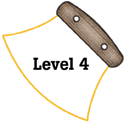
Alaska Science
Key Element C8
 |
Alaska Science |
|
Performance Standard Level 4, Ages 15–18
|
|
|
|
Sample Assessment Ideas
|
|
|
Expanded Sample Assessment Idea
|
|
Procedure Students will:
Reflection and Revision
|
Levels of Performance |
||
|
Stage 4 |
Student demonstrates extensive understanding of traditional beliefs, societal viewpoints and scientific evidence regarding a phenomenon of the natural world. Student defends a position and maintains an open mind toward the opposing evidence or belief. | ||
|
Stage 3
|
Student demonstrates a clear understanding of traditional beliefs, societal viewpoints and scientific evidence regarding a phenomenon of the natural world. Student defends a position but may choose to ignore certain aspects of the opposing evidence or belief. | ||
|
Stage 2
|
Student demonstrates an understanding of traditional beliefs, societal viewpoints or scientific evidence regarding a phenomenon of the natural world. Student defends a position but ignores or belittles the opposing evidence or belief. | ||
|
Stage 1
|
Student demonstrates a limited understanding of traditional beliefs, societal viewpoints or scientific evidence regarding a phenomenon of the natural world. Student defense of a position lacks detail and contains errors and misconceptions regarding the evidence or beliefs. | ||
Standards Cross-References
|
||
|
National Science Education Standards Recognize and analyze alternative explanations and models. This aspect of the standard emphasizes the critical abilities of analyzing an argument by reviewing current scientific understanding, weighing the evidence, and examining the logic so as to decide which explanations and models are best. In other words, although there may be several plausible explanations, they do not all have equal weight. Students should be able to use scientific criteria to find the preferred explanations. (Page 175) Communicate and defend a scientific argument. Students in school science programs should develop the abilities associated with accurate and effective communication. These include writing and following procedures, expressing concepts, reviewing information, summarizing data, using language appropriately, developing diagrams and charts, explaining statistical analysis, speaking clearly and logically, constructing a reasoned argument, and responding appropriately to critical comments. (Page 176) Scientific explanations must adhere to criteria such as: a proposed explanation must be logically consistent; it must abide by the rules of evidence; it must be open to questions and possible modification; and it must be based on historical and current scientific knowledge. (Page 176) Scientists are influenced by societal, cultural, and personal beliefs and ways of viewing the world. Science is not separate from society but rather science is a part of society. (Page 201) Because all scientific ideas depend on experimental and observational confirmation, all scientific knowledge is, in principle, subject to change as new evidence becomes available. The core ideas of science such as the conservation of energy or the laws of motion have been subjected to a wide variety of confirmations and are therefore unlikely to change in the areas in which they have been tested. In areas where data or understanding are incomplete, such as the details of human evolution or questions surrounding global warming, new data may well lead to changes in current ideas or resolve current conflicts. In situations where information is still fragmentary, it is normal for scientific ideas to be incomplete, but this is also where the opportunity for making advances may be greatest. (Page 201) |
Benchmarks No matter how well one theory fits observations, a new theory might fit them just as well or better, or might fit a broader range of observations. In science, the testing, revising, and the occasional discarding of theories, new and old, never ends. This ongoing process leads to an increasingly better understanding of how things work in the world but not to absolute truth. Evidence for the value of this approach is given by the improving ability of scientists to offer reliable explanations and make accurate predictions. (Page 8) In the short run, new ideas that do not mesh well with mainstream ideas in science often encounter vigorous criticism. In the long run, theories are judged by how they fit with other theories, the range of observations they explain, how well they explain observations, and how effective they are in predicting new findings. (Page 13) New ideas in science are limited by the context in which they are conceived; are often rejected by the scientific establishment; sometimes spring from unexpected findings; and usually grow slowly through contributions from many investigators. (Page 13) |
|
Table of Contents | Return to Alaska Native Knowledge Network